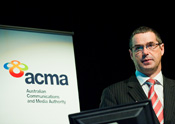Radio broadcasting was largely off the agenda at the RadComms 2010 conference, most likely because radio broadcast band frequencies are not part of the sometimes controversial ‘restacking’ Digital Dividend plan. From a spectrum point of view, the radio industry has consistently put forward a view that it needs sufficient spectrum to provide for national transmission of digital radio, but, in the face of other bigger issues being discussed at the conference, this seemed to be a minor and largely uncontroversial issue.
Digital TV and Restacking:
With the first round of analog television switch-off due in south western NSW in 56 days, several speakers made the point that achieving digital switch-on and analog switch-off will have taken 13 years by the time the process is finished, more time than it took to convert to decimal currency and more time than two world wars.
FreeView’s Julie Flynn told the conference that the free tv industry has invested significant capital into digital tv and faces large risks as analog is turned off. In the face of this challenge, she says the tv industry is worried by other spectrum issues such as the possibility of losing frequencies used for wireless mics and OB links, and the possibility that the tv industry may not have enough spectrum left to broadcast new technologies such as 3Dtv and DVB-T and MPEG4 transmissions if restacking results in all spare frequencies being sold off.
The concept behind restacking is to examine blocks of spectrum that had been allocated for a particular purpose, such as outside broadcasts, wireless microphones or Television News Gathering links. In the past large bandwidth was required and gaps were left between each allocation to make way for expansion and prevent interference. With today’s improved technology those previous issues can be more easily solved, so the restacking concept is to push all the users together in one section of the band and create a contiguous block of space for other uses, that can then be sold off to deliver better outcomes for users and customers, and generate a profit for government. As spectrum is in hot demand this appears to be an attractive solution for tecos, but not one entirely favoured by television broadcasters, who realise the merits of the argument but want to guarantee that their OBs are not compromised.
Mobile phones and data:
The telecommunications industry is now a major player when it comes to spectrum, because of the ever increasing demand for mobile voice and data services. Australian Mobile Telecommunications Association CEO Chris Althaus told the conference that internet enabled smart phones will be used by 40% of the world’s mobile phone users by 2013, and that user generated content, social networking, and online video are driving the next wave of demand for expansion.
“Facebook only began in 2004 and it now has 400 million users, with 25% of them using Facebook on a mobile device.”
There are 5 billion mobile phone subscribers in the world and 24.2 million of them live in Australia according to figures presented by Althus, who says demand is still growing, especially for mobile broadband services.
A later speaker, David Havyatt, coming from the point of view of an ISP provider, asserted that the reason for the increased use of Facebook on mobile phones was probably because people were “using it as a cheaper alternative to SMS because SMS is the most expensive messaging service on earth.”
Department of Broadband, Communications and the Digital Economy (DBCDE) Assistant Secretary Pip Spence, who has spent one year in the job and will soon move on to another section after a restructure, highlighted the digital dividend and the expiry of the first round of spectrum licences as the two top issues the Department is working on. She said the Communications Minister had provided some certainty for 15 year spectrum licence holders, saying their licences are likely to be automatically renewed, subject to a suitable agreement on price.
Emergency Services radio interoperability
As pointed out in numerous disaster inquiries since the Canberra bushfires in 2003, Australia uses state based two way radio systems for emergency services. This flawed system does not let emergency services staff from NSW talk to colleagues just over the border in Canberra because they are two different states which use two different radio systems. Until now.
At the conference a huge step forward in this area was announced. The ACMA has achieved “harmonisation of frequencies” in the 400 MHz band to allow emergency services radio networks to talk to each. The success of the project was demonstrated when three state emergency service executives talked to each other during the conference from their differing two way radio systems.
The new system, as it rolls out to all states, will decrease costs and infrastructure, and will reduce spectrum use. The emergency services team congratulated the ACMA on the success of this project and said it will bring “a significant change of culture to sharing of information across emergency service networks.”
Smart Infrstructure:
ACMA’s Bridget Lally spoke about Smart Infrastructure which can deliver more to business and households by telemetry and remote control. “Systems with a brain,” as she described them, are enabled by the provision of spectrum.
She was followed by Smart Grid Australia’s Robin Eckerman who gave an example of a smart grid in the electricity sector. He described improvements that could be made to the efficiency of electricity consumption by such things as continuous remote monitoring for fallen power lines or increased efficiency of transformers and sub stations through remote control of performance. Another example was that intelligent machines, talking to each other through radio telecommunications, could help reduce the load on power grids in peak time.
Other examples such as remote monitoring of road conditions and machine to machine anti-collision devices were also discussed.
The conference was facilitated by master of ceremonies Malcolm Long, an ACMA part time board member, pictured below.

DBCDE’s Pip Spence

FreeView’s Julie Flynn


The conference agenda is at the link below.

